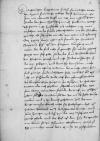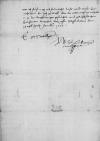Es seinn mir abermols briffe ann E(wer) G(naden) vonn meÿnne(m) gutten brwder, dem hernn Nikolaus Nibschitz (Mikołaj Nipszyc) (*ca. 1483 – †1541), royal courtier, diplomat in the service of Sigismund I and Albrecht von Hohenzollern-Ansbach, Dantiscus' friend; from 1525 until his death an official representative of Duke Albrecht at the Cracow royal court; from 1532 royal secretary; 1519 royal envoy to Albrecht von Hohenzollern, Grand Master of the Teutonic Order, 1525, 1526 envoy to Hungary, 1527 envoy to the Congress in Wrocław, 1531-1533, 1537 envoy to Ferdinand I of Habsburg, 1535-1537, 1540 envoy to Brandenburg, 1536 envoy to the estates of Livonia⌊NÿbschiczNikolaus Nibschitz (Mikołaj Nipszyc) (*ca. 1483 – †1541), royal courtier, diplomat in the service of Sigismund I and Albrecht von Hohenzollern-Ansbach, Dantiscus' friend; from 1525 until his death an official representative of Duke Albrecht at the Cracow royal court; from 1532 royal secretary; 1519 royal envoy to Albrecht von Hohenzollern, Grand Master of the Teutonic Order, 1525, 1526 envoy to Hungary, 1527 envoy to the Congress in Wrocław, 1531-1533, 1537 envoy to Ferdinand I of Habsburg, 1535-1537, 1540 envoy to Brandenburg, 1536 envoy to the estates of Livonia⌋, an E(wer) G(naden) zcwkomen, / welche ich hiemit E(wer) G(naden) zcwschicke, / aus welchenn E(wer) G(naden) wirt vorstehenn, wie der friede allenthalbenn mit dem The Ottoman Turks (Turcae) ⌊TurckenThe Ottoman Turks (Turcae) ⌋ gemacht. / Es cf. Cornelis DE SCHEPPER to Ioannes DANTISCUS Vienna, 1533-03-27, CIDTC IDL 922⌊schreÿbetcf. Cornelis DE SCHEPPER to Ioannes DANTISCUS Vienna, 1533-03-27, CIDTC IDL 922⌋ mir aber vonn Vienna (Wien, Vienna), city in eastern Austria, on the Danube river⌊WiennVienna (Wien, Vienna), city in eastern Austria, on the Danube river⌋ aus Austria⌊OsterreichAustria⌋, dat(um) XXVIII(!) instead of XXVII⌈XXVIII(!)XXVIII(!) instead of XXVII⌉ Marcÿ, / meÿnn gut freundt her Cornelis De Schepper (Cornelius Scepperus, Cornelis De Dobbele, Cornelius Duplicius) (*1503 – †1555), erudite, diplomat in the Habsburgs' service; close friend of Ioannes Dantiscus; initially in the service of Christian II of Oldenburg, King of Denmark; 1526 secretary and councillor to Emperor Charles V of Habsburg (CE, vol. 3, p. 218-220; DE VOCHT 1961, p. 15-24)⌊Cornelius ScepperusCornelis De Schepper (Cornelius Scepperus, Cornelis De Dobbele, Cornelius Duplicius) (*1503 – †1555), erudite, diplomat in the Habsburgs' service; close friend of Ioannes Dantiscus; initially in the service of Christian II of Oldenburg, King of Denmark; 1526 secretary and councillor to Emperor Charles V of Habsburg (CE, vol. 3, p. 218-220; DE VOCHT 1961, p. 15-24)⌋, Charles V of Habsburg (*1500 – †1558), ruler of the Burgundian territories (1506-1555), King of Spain as Charles I (1516-1556), King of Naples and Sicily, King of the Romans (1519-1530), Holy Roman Emperor of the German Nation (elected 1519, crowned 1530, abdicated 1556); son of Philip I the Handsome and Joanna the Mad of Castile⌊kaÿ(serliche)r m(aieste)tCharles V of Habsburg (*1500 – †1558), ruler of the Burgundian territories (1506-1555), King of Spain as Charles I (1516-1556), King of Naples and Sicily, King of the Romans (1519-1530), Holy Roman Emperor of the German Nation (elected 1519, crowned 1530, abdicated 1556); son of Philip I the Handsome and Joanna the Mad of Castile⌋ inn Hungary (Kingdom of Hungary)⌊HungernnHungary (Kingdom of Hungary)⌋ co(m)missari(us) unnd orator, / das der frid nicht so gemacht seÿ, wie des woÿwod(en) parteÿ vonn sich gibt, / sunder, / das so nu der The Ottoman Turks (Turcae) ⌊TurckeThe Ottoman Turks (Turcae) ⌋ czwir inn Hungernn gewest / unnd nicht sunders ausgericht, / so dar vonn geczogenn / unnd domit beÿ denn seinen / nicht wenigk seiner achtung vorlorenn, / das er nicht allein zcum frid geneigt, / sunder auch begert habe / unnd Ferdinand I of Habsburg (*1503 – †1564), from 1521 Archduke of Austria, from 1526 King of Bohemia and Hungary, Croatia and Slavonia as Ferdinand I, 1531-1558 King of the Romans, 1558-1564 Holy Roman Emperor; son of Philip I the Handsome and Joanna the Mad of Castile, a younger brother of Charles V of Habsburg⌊ro(misch)e ko(niglich)e m(aieste)tFerdinand I of Habsburg (*1503 – †1564), from 1521 Archduke of Austria, from 1526 King of Bohemia and Hungary, Croatia and Slavonia as Ferdinand I, 1531-1558 King of the Romans, 1558-1564 Holy Roman Emperor; son of Philip I the Handsome and Joanna the Mad of Castile, a younger brother of Charles V of Habsburg⌋ nicht ein fuszbreidt lands, / auch kein pfennigk tributs, das konigkreich zcw Hungernn zcw besiczenn, / im hab abgetrettenn oder noch gegebenn. / Schreibt mir auch, das, / wÿe sein altenn, vortrautenn freundt, / domit ich sein gloe superinscribed⌈ee superinscribed⌉ben(n) gebenn sol, / d written over ...⌈... illegible⌈...... illegible⌉dd written over ...⌉as concilium sol im jor mit der stelle benu(m)pt werdenn / unnd II jor dornoch gehaltenn, / it(e)m, das vom Francis I of Valois (*1494 – †1547), 1515-1547 King of France; son of Charles, Count of Angoulême, and Louise of Savoy⌊konige vonn FranckreichFrancis I of Valois (*1494 – †1547), 1515-1547 King of France; son of Charles, Count of Angoulême, and Louise of Savoy⌋ nichts seÿ zcwbesorgen. / Charles V of Habsburg (*1500 – †1558), ruler of the Burgundian territories (1506-1555), King of Spain as Charles I (1516-1556), King of Naples and Sicily, King of the Romans (1519-1530), Holy Roman Emperor of the German Nation (elected 1519, crowned 1530, abdicated 1556); son of Philip I the Handsome and Joanna the Mad of Castile⌊Kaÿ(serlich)e m(aieste)tCharles V of Habsburg (*1500 – †1558), ruler of the Burgundian territories (1506-1555), King of Spain as Charles I (1516-1556), King of Naples and Sicily, King of the Romans (1519-1530), Holy Roman Emperor of the German Nation (elected 1519, crowned 1530, abdicated 1556); son of Philip I the Handsome and Joanna the Mad of Castile⌋ hab inn Italy (Italia)⌊ItaliennItaly (Italia)⌋ VII-M deutscher alter knecht / unnd sovil spaniger / unnd bisz inn die VIII-M schwere und geringe pferde, / unnd das kaÿ(serlich)e m(aieste)t denn XIIII dis monadts vonn Genoa (Genova, Genua, Ianua), city and capital of the homonymous Republic in north-western Italy, Liguria, on the Gulf of Genoa, a seaport from 1528 ally and satellite of Spain⌊GenuaGenoa (Genova, Genua, Ianua), city and capital of the homonymous Republic in north-western Italy, Liguria, on the Gulf of Genoa, a seaport from 1528 ally and satellite of Spain⌋ sol inn Spain (Hispania)⌊HispaniennSpain (Hispania)⌋ uberfarenn. / Sunst ist beÿ mir nichts newes, das E(wer) G(naden) nicht vor geschriebenn.  GStA, PK, HBA, C 2, No 38, f. 1v Wor ich sunst E(wer) G(naden) vil fruntlichs dinsts werde wissen zcwerczeigenn, bin ich wÿlligk. / Gott der allemechtige enthalde E(wer) G(naden) inn langkweriger gesuntheit / unnd gelugkseligem zcunhemenn lang czeit. /
GStA, PK, HBA, C 2, No 38, f. 1v Wor ich sunst E(wer) G(naden) vil fruntlichs dinsts werde wissen zcwerczeigenn, bin ich wÿlligk. / Gott der allemechtige enthalde E(wer) G(naden) inn langkweriger gesuntheit / unnd gelugkseligem zcunhemenn lang czeit. /
 GStA, PK, HBA, C 2, No 38, f. 2v
GStA, PK, HBA, C 2, No 38, f. 2v  GStA, PK, HBA, C 2, No 38, f. 1r
GStA, PK, HBA, C 2, No 38, f. 1r  GStA, PK, HBA, C 2, No 38, f. 1v Wor ich sunst E(wer) G(naden) vil fruntlichs dinsts werde wissen zcwerczeigenn, bin ich wÿlligk. / Gott der allemechtige enthalde E(wer) G(naden) inn langkweriger gesuntheit / unnd gelugkseligem zcunhemenn lang czeit. /
GStA, PK, HBA, C 2, No 38, f. 1v Wor ich sunst E(wer) G(naden) vil fruntlichs dinsts werde wissen zcwerczeigenn, bin ich wÿlligk. / Gott der allemechtige enthalde E(wer) G(naden) inn langkweriger gesuntheit / unnd gelugkseligem zcunhemenn lang czeit. /


